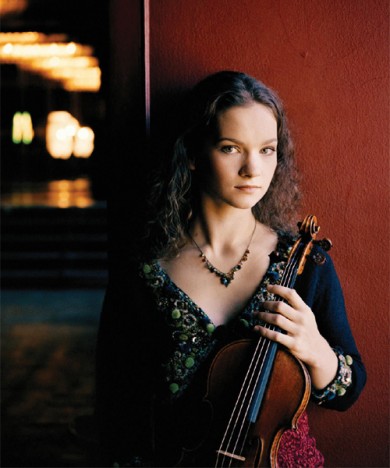Hilary Hahn mixes old and new with supreme artistry

Hilary Hahn performed a wide-ranging recital Thursday night at the Arsht Center.
Hilary Hahn offered a fascinating solo recital on Thursday night for the Arsht Center’s classical series. The thirty-three year old violinist has made a graceful transition from gifted child prodigy to globetrotting virtuoso. Eschewing the safe, audience-friendly mix of classical and romantic showpieces that have become the all-too-familiar formula for most recitalists, Hahn offered a postmodern program prominently featuring eight of the twenty-seven encore pieces she has commissioned from a diverse group of contemporary composers. She offset the new works with Baroque scores by Bach and Corelli and a masterpiece from the twilight of romanticism.
The scores from Hahn’s encore project were dispersed throughout the program rather than played consecutively, producing a contrast of old and new, classical tradition and vernacular populism.
Richard Barrett’s Shade was an angular bagatelle, the tonal ambiguity of the violin line and emphatic piano chords creating a pensive aura. Aalap and Tarana by Kala Ramnath offered a haunting Middle Eastern melody that gradually turned into bravura fireworks. The mood swings of Anton Garcia Abril’s First Sign were volatile, sad and joyous in rapid succession. Memories by Michiru Oshima offered wispy, ruminative angst, a modernist reboot of romanticism.
Impulse by Franghiz Ali-Zadeh was an old-fashioned virtuoso showpiece, Hahn playing at a breakneck pace with remarkable tonal brightness. James Newton Howard’s 133…At Least sang in funky, neo-Baroque tones. David Del Tredici’s Memories offered long breathed, lyrical lines that Hahn assayed with full, dark-hued tone and impassioned fervor. Ford’s Farm by Mason Bates fused country fiddling with Paganini-style pyrotechnics and speed. Hahn’s dazzling, fearless performance brought the exceptionally attentive audience to its feet. The overall high quality of these new pieces is a tribute to her artistry and insightful choices.
An inquisitive and adventurous artist, Hahn has studied period performance practices of Baroque music. Her performances of the Chaconne from Bach’s unaccompanied Partita No. 2 and Corelli’s Sonata No. 4 were marked by spare vibrato, clean and immaculately projected inner voicing and springy, dance infused tempos. The double stops in the solo Bach piece were wonderfully accurate, the tone light and transparent. There was a sense of soulful introspection in the Bach and the opening Adagio of the Corelli sonata, the final Allegro taken at a rapid clip but never seeming rushed.
Faure’s Sonata No. 1 is a beautiful, richly melodic score, easily the equivalent of the over-played Franck Violin Sonata. Hahn’s soaring tone and forward thrust attacked the opening Allegro molto with uninhibited passion. She spun the grave melodic threads of the Andante with winning restraint and offered a brisk and playful take on the Scherzo. Her emotionally charged reading of the finale capped a probing, high-powered performance replete with bursts of Gallic infused song.
For an encore Hahn turned to Two Pieces by Valentin Silvestrov, a contemporary mashup of Tchaikovskyan elegance and sentimentality with a contemporary harmonic spin. Whether playing long melodic lines, rapid figurations or complex harmonics, Hahn’s technical mastery and intellectually acute musicianship were impressive.
Cory Smythe was a stellar piano partner. A modern music specialist, Smythe brought accuracy and acute musicality to the swings of mood and meter in the contemporary scores. His sensitive, light touch enlivened the Corelli and he offered surprising emotional heft in the important keyboard line of the Faure. Always attentive to Hahn’s turns of rhythm and phrase, Smythe proved a model accompanist.
Posted in Performances
Leave a Comment
Fri Feb 15, 2013
at 11:59 am
No Comments






